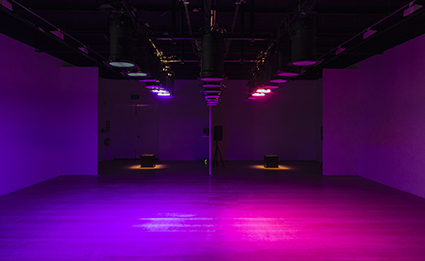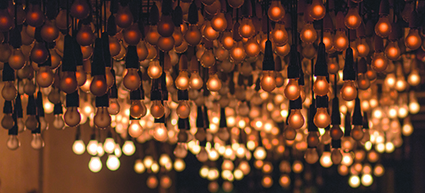The sound beyond & the light inside
Andrew Harper: Dark MOFO: Envelop(e); Angry Electrons

Jason James, Crevasse, envelop(e)
courtesy the artist and Dark MOFO festival
Jason James, Crevasse, envelop(e)
Matt Warren’s show Envelop(e) at Contemporary Art Tasmania is very much a culmination of ideas he’s been investigating for much of his career. His own work has long featured sound, so the move into curation in 2012 with A Silent Way seemed logical and has been revealed in Envelop(e) as a rich extension of his overall practice. Jason James, another Tasmanian artist who is at a much earlier stage of his career, contributed a new work to Envelop(e) while also debuting an ambitious installation, Angry Electrons, in a docking bay at the Centre for the Arts (see Profiler 11 at www.realtimearts.net for more on the artist and video of the work).
Envelop(e) comprises four sound works from Elizabeth Veldon, Christina Kubisch, Mick Harris and Julian Day, plus Jason James’ light installation Crevasse. While each has its own governing set of impulses and logical formatting, a powerful overall effect is realised by Warren’s careful arrangement of the works in a sparely lit space with open cubicles somewhat akin to listening stations—three of the four each with a small seat. The effect is monastic. Hanging at the centre is James’ Crevasse, a bank of 21 stage lights—1000 watt Par Cans—changing hue, seeping on and off. The overall arrangement of the exhibition implies ritual, attempting to slow viewers down—a seat probably helps, but it’s the setting that largely creates the palpably reverential tone.
Elizabeth Veldon’s The Tortoise History of Our Voyage stands out by breaking the sound-art mould, using texts gleaned from the journals of Charles Darwin on his visit to Hobart in 1836. Voices overlap and interlock, leaving potential for listeners to ascribe new meanings or just enjoy the cadences. Mick Harris, famed as the drummer for the extreme metal act Napalm Death, contributes two interwoven drone works that evoke the edges of dream worlds, while German composer Christina Kubisch presents sound from her installation Movements to Distant Places, an exploration of the sounds generated by the electromagnetic forces that shift around us. As with Veldon’s, both works create a spectral sense of the distances of history, geographic dislocation or the melting worlds of the subconscious.
Julian Day’s visually and sonically delicious Requiem features two identical “heirloom” synthesizers mounted on opposing walls and linked by eight silver rods which hold down keys, generating a drone. This sculptural work combines wit with a take on classic minimalism, becoming one of those ‘anyone-could-have-done-it-but-they-didn’t’ works that stand out as being in equal parts beautiful and clever.
Jason James writes, “Ever since hearing about explorers dying by falling into crevasses I have wondered what it must be like to be dying somewhere that is both beautiful and deadly”. An attempt to render the light seen from the bottom of an ice cave, Crevasse rolls slowly through cool and frozen light states: blues, stark whites, toxic lilacs. It felt cold, very cold. Its strongest effect is as a kind of visual subtext to the softly meshing sounds of the gathered art works that becomes the slowly pulsing centre of the room. The brazenly open display of the light source just above the heads of visitors, calls to mind a weird aircraft, possibly with occult or alien origins, its patternings reminiscent of coding or signalling—oddly triggering a desire to decode. Matt Warren’s art has long attempted this kind of evocation and it’s a fascinating eventuality that one of his most successful efforts should come from his work as a curator.

Jason James, Angry Electrons
courtesy the artist and Dark MOFO festival
Jason James, Angry Electrons
At a docking bay in the Centre for the Arts, James’ large-scale installation Angry Electrons marries motion sensors to a floating sea of 1000 light bulbs in a dance of glowing electricity that moves above in reaction to the audience moving below. Bristling with rude and lively energy, Angry Electrons successfully achieves something extraordinarily complex in technical terms if not in evoking the danger of electricity the artist intended. The many people who saw this installation almost universally played with it—children in particular ran about, delighted as they realised their movements were causing the brisk dancing above their heads. The potential for realising electrical terror might have been effected by hanging the bulbs lower, but practical issues of health (the effects of intense light on eyesight) and safety (the risk of someone touching and breaking a bulb) required the angry electrons to be contained by elevating their glass cages.
The stark concrete docking bay was transformed into a space of fleeting beauty, filled with excited, giggling shrieks; humans are possibly less predictable than electricity. Angry Electrons was not frightening, but thrilling, fun and incredibly engaging. James’ Crevasse felt far more sinister, conjuring up a sense of the irrational and the eerie.
Dark Mofo 2015: Envelop(e), curator Matt Warren, artists Elizabeth Veldon, Julian Day, Mick Harris, Christina Kubisch, Jason James, Contemporary Art Tasmania, 11 June-19 July; Angry Electrons, Jason James, Centre For The Arts, 12–21 June
RealTime issue #128 Aug-Sept 2015 pg. 52






